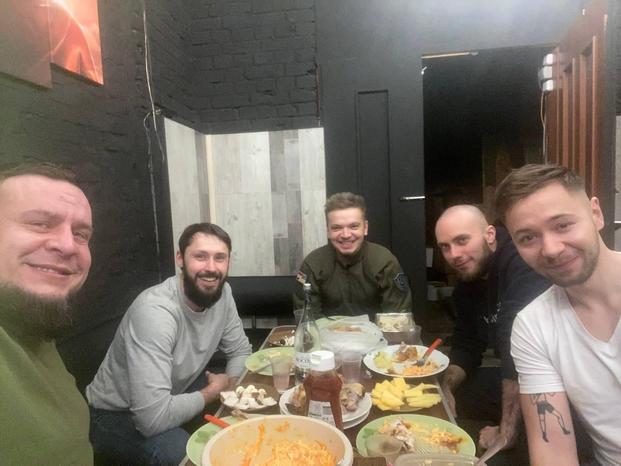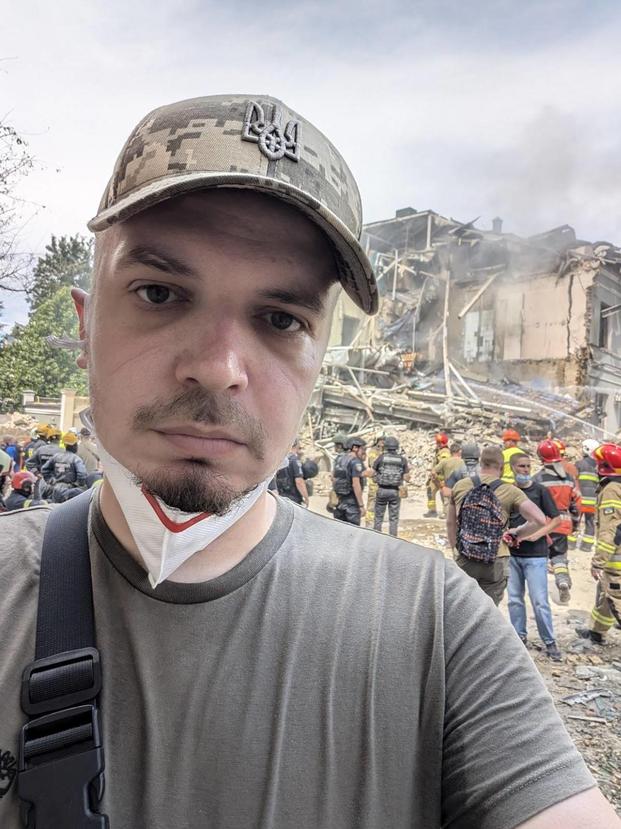This is the first of a two-part, originally produced, series by Military.com.
Jack de Santis remembers what it was like growing up in a war-torn country.
Once he became of age and witnessed the peril suffered by Ukrainians at the hands of Russia in February 2022, the drone pilot and engineer felt an obligation to go there and help. So, he did.
The Croatian-born de Santis, 34, saw firsthand the effects of war as the conflict in the Balkans (also known as the Yugoslav Wars) originated around the time of his birth in 1990. While extremely young, the experience ultimately prepared him to make his own sacrifices.
“[It] left me with a very strong sense when I saw the full-scale invasion start in Ukraine,” de Santis told Military.com. “I said I really didn't want to just sit and watch it in the news and do nothing about it, because it reminded me a lot of my childhood in Croatia.”
His urge to help Ukraine was temporarily dissuaded by his lack of knowing how. He had no prior military experience that could help in the war’s immediacy, where ground warfare swiftly became deadly and destructive. Casualties on both sides of the border accumulated.
He possessed a background in computer hardware engineering, however, working in the tech sector to build and assist startup companies. He also perfected his hobby of piloting drones, which became an interest of his during his teenage years.
That ultimately led to foraging his path into the warzone in Eastern Europe months after Russia’s invasion, its second major military foray into Ukraine in less than a decade.
“I was quite proficient at flying drones, fixing drones, hacking drones, building drones,” he said. “So, it turned out to be very useful to the Ukrainians, even more so than if I was like an infantryman or something.”
'Scene Out Of A Movie'
In February 2022, the still-ongoing war perpetrated by Russia against Ukraine instantly caught the attention of de Santis and the rest of the world.
Like others, he saw what was taking place near Ukraine’s eastern border over days and weeks and did not want to sit idly as casualties began to climb, families were split, and communities were succumbing to complete ruin.

He was not bogged down by any familial obligations, either. His mother and father died several years before the war; his sister died in Croatia when he was a small child. He had a girlfriend at the time who was Ukrainian and “quite happy” that he went to fight for her nation.
Months before his arrival on Ukrainian soil, de Santis began engaging with several Ukrainian military units and with foreigners on social media. He shipped thousands of dollars’ worth of equipment over to individuals he soon began working with regularly, developing a strong rapport.
The first time he went to Ukraine was September 2022, where he linked with folks like Major Egor Pershin who has been affiliated with the 59th Assault Brigade and was running Ukraine’s White Ghost drone program.

By the time he landed in Ukraine, de Santis had developed some camaraderie with Pershin and other Ukrainian figures due to his support via donations and equipment.
“I remember the first time I arrived in Kiev, I arrived in the middle of the night and they have the curfew,” said de Santis, who was living in Portugal before he trekked to Ukraine. “Only in the military, it's allowed to move around.
“I remember arriving at this checkpoint at the perimeter of the city and the military was there, they had like an oil barrel with a fire inside of it…and the military tent and the soldiers were standing there.”
Pershin, who later retired in 2023, picked up de Santis at the checkpoint and drove through a deserted city on the way to Pershin’s residence.

“Because of the curfew, nobody was outside—and Kiev is this multi-million person city,” de Santis said. “It was such a surreal scene not to see a single person out on the street, not even a stray dog.
“And then during our ride home, an air raid alert siren starts going off. It really felt like a scene out of a movie or something. But what I felt in that moment was, like, I'm home and this is where I belong and this is where I should be.”

His touchdown in Ukraine in December 2022 was not temporary. He spent essentially all of 2023 and 2024 in Eastern Europe, finally leaving on January 3, 2025.
Fear Can Be ‘Healthy’
Fear was in the back of de Santis’ mind but never overtook it.
“I would say it was a little bit scary in the beginning because I didn't really know what to expect,” he said. “I didn't really know what this was going to look like and feel like.
“But I very quickly saw how things are and how things go, and I got a sense of what is dangerous and what is not. And then the fear mostly goes away at that point.”

He described himself as perhaps “reckless” at times, running onto a rooftop in the immediate aftermath of a siren’s eruption to monitor the surrounding area and check for artillery strikes in the vicinity.
Having a little bit of fear is “actually healthy to have,” he said, as “it will stop you from doing some stupid things.”
It’s also a different scenario from being on the frontlines, he added.
“Even in situations where I was on the frontline and I was just sitting under a barrage of artillery fire, there is nothing you can really do about it,” he said. “It's just a lottery, it's just luck. You just hope it doesn't hit right on you.
“So, that feeling in a sense made me not afraid because I knew there was nothing I can do about it. There is nothing I can do to influence this. So, just enjoy the ride and if [death] happens, it happens. If not, I’ll go on and live another day.”
He suffered what he described as two minor injuries during his time abroad.
Once, de Santis was standing right next to a two-story building that collapsed with part of a wall falling on his leg.

The other instance, he was on the second floor of a half-destroyed building. He stood too close to an opening when the structure was attacked from the other side.
“Everything shook and I fell out of the building from the second floor,” he said. “And as I put my arm [down] to catch myself instinctively, as I was hitting the ground, I broke my shoulder.”

Knowing Daniel Burke
Working in Kyiv on the White Ghost drone program was the major priority for de Santis when committed himself in December 2022.
Around that same time was when he met ex-British paratrooper Daniel Burke, who led the unit Dark Angels in the war’s infancy that consisted of British, French and American volunteer soldiers with varied military experience.
Burke was described as a “best friend” of sorts.
“I hung out with him in Kyiv for a while,” de Santis recalled. “And then when the Dark Angels were going back to Bakhmut in January 2023, he said, ‘Hey, we're going to Bakhmut tomorrow. We don't have anybody on our team who knows how to use drones. Would you be interested in coming with us?’
“I just said, ‘Yeah, sure, let's go.’ And then 24 hours later, I was in the fiercest battle on European soil since Stalingrad.”

Burke was previously known for his previous volunteer work in Syria in 2017 when he fought the Islamic State. He ultimately went missing from the Zaporizhzhia region of Ukraine in August 2023, and his bodily remains were reportedly discovered in an underground pipe at a military training ground.
Burke’s death was attributed to a shooting committed by Ukrainian fighter Abdelfetah “Adam” Nourine, also known as "Jihadi Adam", who allegedly told Ukrainian authorities the fatal shooting was an accident that occurred as both individuals were practicing drills some 27 miles away from the war’s frontlines.
Last December, Manchester Area Coroner Zak Golombeck said the 36-year-old Burke "died with bravery and valour and was sadly killed by cowardice and dishonor.” He also refuted claims of the death being an accident.
Lessons Learned
About 3 1/2 years since Russia’s full-scale invasion was launched, de Santis also subscribes to the widespread description of the war being a “stalemate.”
In June 2025, the Center for Strategic & International Studies estimated that 950,000 Russian soldiers had been killed (250,000) or injured (700,000). A January 2025 estimate by Ukrainian President Volodymyr Zelensky approximated at the time that 400,000 Ukrainian soldiers were killed or injured, with another 35,000 missing.
That first year of the conflict was like “the wild West,” de Santis said, referencing how central command was nowhere to be seen and how fighters were self-organizing to company and battalion levels.

When Burke and the Dark Angels came onto the scene just prior to de Santis, they were essentially told by Ukrainian Armed Forces officials that small weapons and javelins were available.
“Take what you can carry,” Ukrainian officials would say, according to de Santis. “Russian military in that direction. Good luck.”
Things became somewhat more normalized as warfare increased and a conventional military was developed. But for de Santis, he operated in a similar manner—with no paperwork, no enlistment requirements, no contract with White Ghost, and nobody asking for his identification.
He is now using his personal experience in Ukraine along with his drone expertise to help expand the capabilities of electronic warfare on grander scales.















